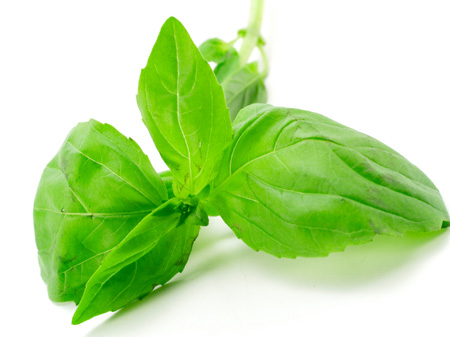Greek name and pronunciation:
Vasilikos, βασιλικός, pronounced vah-see-lee-KOHS (rhymes with “dose”)
At the market:
Expect to find at least one variety of basil at your green grocer or supermarket. Green basil is the most comonly used variety for cooking. Fresh basil leaves are packaged in 2- to 4-ounce disposable containers. Dried basil is available in sprinkle-pour bottles.

Basil herb
Physical characteristics:
Species of basil range in height from 8 to 40 inches, with leaves varying in size (1 1/2 to 4 inches), shape (oval, smooth, or with tooth-like edges) and color (green, violet, and blackish). The scent of each species differs, reminding one of lemon, incense, cinnamon, clove, etc. In your market, fresh sweet green basil is usually available.
Usage:
Basil may be used (in general) whenever a recipe contains tomatoes. It goes well with other vegetables, soups, salads, eggs, seafood, meat, and game. It is the main ingredient in pesto sauce. Fresh basil is much preferred over dried basil.
Substitutes:
oregano, thyme, tarragon, summer savory, equal parts parsley and celery leaves, or cilantro (which works well in pesto).
In Your Garden:
Basil is a tropical plant that may be adapted to temperate and colder climates via potting containers brought indoors during the winter. Varieties of particular interest to someone planning a kitchen herb garden are:
- African Blue Basil with medium-sized, dark green leaves that work well in salads or sauces;
- Genovese Basil, probably the best basil for pesto;
- Cinnamon Basil which may be used both as a culinary herb in pestos and sauces and as a fragrant herb in potpourris.
Origin, History, and Mythology:
Hippocrates regarded basil as beneficial to the heart and prescribed it for treatment of constipation and as an anti-emetic (to prevent vomiting). Pliny suggested vinegar scented with basil would help prevent fainting. Dioscurides believed basil to be soothing for the stomach and abdomen, and useful as a diuretic and a galactagogue (e.g., an aid in lactation).In 330 A.D., the Holy Cross was found by Aghia Eleni (Saint Helen) in Palestine on a hill that was covered with basil bushes. For this reason, some Greeks do not cook with basil. It is grown and admired for the beauty of its shapes and colors, for its fragrance, and religious significance. Many Greeks bring basil plants as gifts to the church or to have their basil plants blessed by the priest, a blessing for the health and prosperity of their home.It wasn’t until recent years when Italian recipes gained popularity in Greece (i.e., pesto sauce) that basil was used regularly in cooking.
